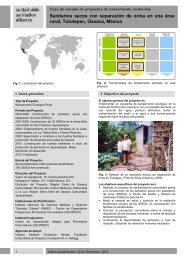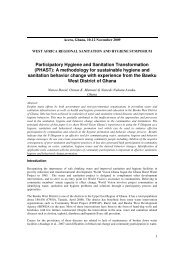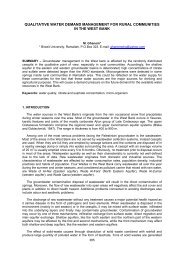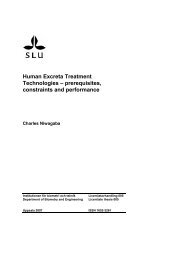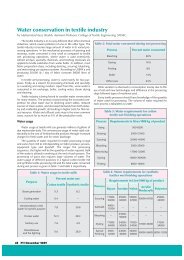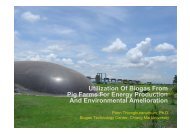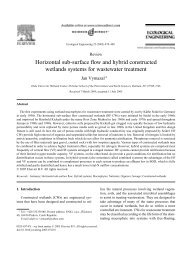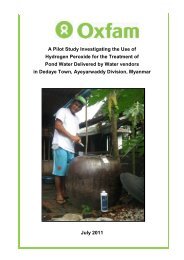Fertigation: Optimizing the Utilization of Water and Nutrients - SSWM
Fertigation: Optimizing the Utilization of Water and Nutrients - SSWM
Fertigation: Optimizing the Utilization of Water and Nutrients - SSWM
You also want an ePaper? Increase the reach of your titles
YUMPU automatically turns print PDFs into web optimized ePapers that Google loves.
<strong>and</strong> livestock products as income levels rise. These trends follow <strong>the</strong> same<br />
general pattern, regardless <strong>of</strong> culture, religion, or geographical location<br />
(Delgado et al., 2002). Because 2-‐4 kg <strong>of</strong> grain are required to produce 1 kg <strong>of</strong><br />
meat or fish, grain dem<strong>and</strong> will rise faster than <strong>the</strong> rate <strong>of</strong> population increase.<br />
Food supply can be predicted from trends in crop yields <strong>and</strong> in <strong>the</strong> arable l<strong>and</strong><br />
area available for crop production, <strong>and</strong> econometric models have been<br />
developed to predict global food dem<strong>and</strong> <strong>and</strong> supply. One <strong>of</strong> <strong>the</strong> most influential<br />
<strong>and</strong> comprehensive food supply-‐dem<strong>and</strong> models is <strong>the</strong> IMPACT model<br />
developed by Mark Rosegrant et al. (2002) at <strong>the</strong> International Food Policy<br />
Research Institute in Washington, DC. According to <strong>the</strong> IMPACT model,<br />
dem<strong>and</strong> for <strong>the</strong> three major cereals is projected to increase at a compound<br />
annual rate <strong>of</strong> 1.29% from 1995 to 2025 (Table 1). This increase is predicted to<br />
come from increases in cereal yields (0.98%/yr) <strong>and</strong> an expansion <strong>of</strong> <strong>the</strong> crop<br />
growing area by 50 Mha.<br />
Table 1. Prediction <strong>of</strong> global aggregate dem<strong>and</strong>, supply, <strong>and</strong> yield <strong>of</strong> <strong>the</strong><br />
three major cereals (maize, rice, <strong>and</strong> wheat) from 1995 to 2025, by <strong>the</strong> IFPRI-‐<br />
IMPACT model‡, <strong>and</strong> a modified prediction based on updated trends in l<strong>and</strong><br />
use.<br />
Population<br />
(109)<br />
Dem<strong>and</strong><br />
(million mt)<br />
Production area<br />
(million ha)<br />
Mean grain yield†<br />
(kg/ha)<br />
‡<br />
1995 2025 Annual<br />
rate <strong>of</strong><br />
change<br />
5.66<br />
1,657<br />
506<br />
3.27<br />
7.90<br />
2,436<br />
556<br />
4.38<br />
%<br />
1.12<br />
1.29<br />
0.31<br />
0.98<br />
Modified<br />
2025<br />
prediction<br />
Same<br />
2,558<br />
491<br />
5.21<br />
Rosegrantet al., 2002, International Food Policy Research Institute.<br />
While <strong>the</strong> IFPRI-‐IMPACT prediction accounts for grain dem<strong>and</strong> for human food<br />
<strong>and</strong> livestock feed, it does not consider grain used for bi<strong>of</strong>uel or bio-‐based<br />
industrial feedstock production; <strong>the</strong> modified prediction assumes that 5% <strong>of</strong><br />
global grain supply in 2025 is used for production <strong>of</strong> bi<strong>of</strong>uel <strong>and</strong> bio-‐based<br />
industrial feedstocks.<br />
†Weighted average for <strong>the</strong> three major cereals.<br />
Modified<br />
annual rate<br />
change<br />
%<br />
1.12<br />
1.46<br />
-‐0.10<br />
1.56<br />
25



